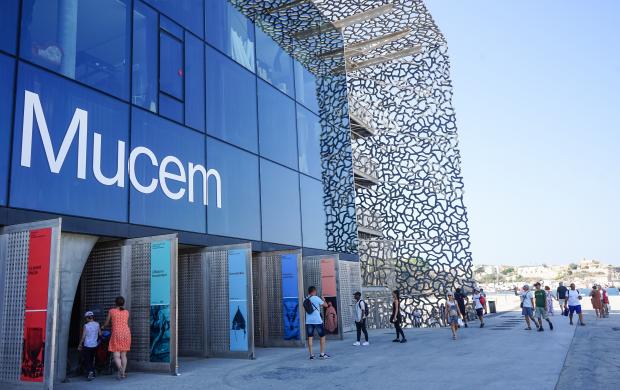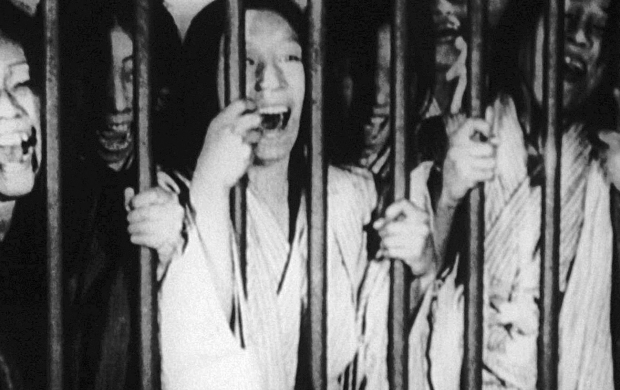Story(ies) of René L.
Contrasting heterotopias
Mucem, fort Saint-Jean—
Bâtiment Georges Henri Rivière
|
From Friday 25 February 2022 to Sunday 8 May 2022
One day during a visit to asylums destined for destruction, our gaze stumbled upon these piles of papers, marked “to be thrown away”. The large room that was for a century a communal dormitory for the disturbed had become the storage area for a set of cardboard boxes. There, against a wall of this psychiatric hospital room, thick rolls of paper were found. Unfolding these sheets, dozens of drawings appeared, some drawn only with black pencil, others conscientiously coloured in.
What were these drawings? The product of a therapeutic workshop? Works of Art Brut? An archive? Enigmatic signs left by an individual called René, each of the drawings was signed.
René Louis L. was born in Perregaux (Oran) on 16 May 1920. His grandparents left Alsace in 1871 following the French defeat in the Franco-Prussian War and moved to the Oranais. René spent his entire childhood in this small colonial community. But after his twenties, he was hospitalised almost continuously in various institutions in Algeria, including the regional hospital in Orléansville and then the one in Blida, for mental disorders, falling into the category of schizophrenia. In 1963, just over a year after Independence, he was repatriated with over one hundred and fifty other patients, men and women who had been receiving psychiatric treatment in Algeria, to the Bon-Sauveur private psychiatric hospital in Picauville in the Manche département in northern France. The admission certificate stated: “Chronic delirium of imprecise structure with hypochondriac theme”. René L. remained in Picauville for the rest of his life.
All that remains of René are these forty or so drawings; what text do they make up?
An exhibition to solve the enigma: to go in search of René L., not in the archives of the Civil Registry or psychiatric institutions, but in History, the great one — the one that is the subject of treaties, the one that shapes cities, the one that determines our lives; inventing René from images, documents, archives, works; to be unafraid of making weak connections, of improbable associations; to risk history; to follow René L., and perhaps, from trace to trace, explore another memory of our present.
This exhibition offers a journey through our twentieth century and the heterotopias of which it was the scene. Taking up Michel Foucault’s concept to designate these “other spaces”, these spaces that bring together in a single place all the places, these worlds that are not fictitious such as utopias, but which are quite real, like so many autonomous islands in the archipelago that makes up our modernity, the exhibition gives us a glimpse of the heterotopias that René L. crossed and largely drew.
The heterotopia of the ship (which transports colonists to Algeria; which, like the cruise liner SS France from the 1960s onwards, is a floating universal exhibition; and, like the shipwrecked vessel represented on a marine ex-voto, speaks of chaos) opens the exhibition and then ventures into the colonial heterotopia. We arrive in the town of Perregaux, with its town hall, post office and courthouse, and visit the large-scale collective housing projects, those dreamed up by Le Corbusier for Nemours and Algiers, and those built by Fernand Pouillon. Through this colonial heterotopia, we will reach the asylum and the model psychiatric hospital of Joinville-Blida. We will discover the primitivist theses of the School of Algiers. As a mirror image, we will follow René L. to the Bon-Sauveur psychiatric hospital in the Manche, after his latter repatriation. There, through a series of his drawings, we will understand the importance of another heterotopia, that of the Olympic Games, those of Grenoble in 1968: we will dream in front of the speed ring and Vasarely’s frescos. We will cross Novarina’s Olympic village.
This progress through correspondences and echoes will be highlighted by four figures who meet in René L.’s stories. First, there will be Michel Foucault at the crossroads of heterotopology and psychiatry; then, Frantz Fanon between psychiatry and colonialism; followed by Le Corbusier at the junction of colonial projects and housing estates; and finally Georges Perec and his island, W, where the sporting heterotopia turns into a nightmare.
In this journey, works will act as beacons: a residence by Etienne-Martin, a cage by Sol LeWitt, a Nude by Fernand Léger, and an athletic figure by Germaine Richier.
Thus, with the biography of an individual who was a psychiatric patient as a story arc, the exhibition offers up another memory of our twentieth century – a fragmented, contradictory and complex memory where dreams collide and are broken, a discontinuous social and cultural memory.
– Curators: Philippe Artières, historian, research director at the CNRS (Iris, EHESS, Paris-Condorcet), et Béatrice Didier, co-director of the Point du Jour art centre, editor and teacher
– Scenography : FREAKS, architecture and scenography agency
-
Interview with Philippe Artières and Béatrice Didier, curators of the exhibition
-
-
Mucem (M.)
Is the story of René L. fact or fiction?
Philippe Artières (P. A.) et Béatrice Didier (B. D.). René L. really did exist; he was born in the early 1920s and died in 1993. All the biographical elements present in the exhibition are accurate; so is his family history, that of those Alsatians who, after the defeat of 1871, were forced to leave for Algeria to remain French. René L.’s life in psychiatric institutions, whether the psychiatric hospital in Blida or the Fondation Bon-Sauveur in Picauville, is also authentic. What we imagined as we looked at the fifty or so drawings that René produced is what he perceived of the history of which he was a contemporary, that of colonisation, that of psychiatry and its reform from the 1960s onwards, as well as that of the architecture of the reconstruction – for instance, Auguste Perret’s Le Havre, or even an event as media-friendly as the arrival of the cruise liner SS France in the 1960s or the Olympic Games in Grenoble in 1968.
M. What is a “heterotopia”? And what are the “contrasting heterotopias” that make up the subtitle of the exhibition?
P. A. et B. D. In a lecture given on 14 March 1967 and published in 1984, the philosopher Michel Foucault gave a very enlightening reading of contemporary spaces. He distinguished two main types: utopias, sites without real places, and also “real places, effective places, places that exist and are formed in the very founding of society, which are something like counter-sites, a kind of effectively enacted utopia in which the real sites, all the other real sites that can be found within the culture, are simultaneously represented, contested, and inverted. Places of this kind are outside of all places, even though it may be possible to indicate their location in reality. [...] I shall call them, by way of contrast to utopias, heterotopias.” The colony, psychiatric hospitals, Olympic villages, but also boats or universal exhibitions are these places that have “the power to juxtapose in a single real place several spaces that are in themselves incompatible.”
If René L. described them as contrasting, it is because in contemporary history they are challenged and contested. It is of this memory that the exhibition tells.M. This exhibition is like an investigation. What exactly will one see?
P. A. et B. D. The exhibition is conceived as a research project; it is not a question of imposing causal links or of fixing a chronology. We are proceeding by making connections, by bringing items closer together. With the scenographer, we thus opted for a presentation on tables which, we believe, reflects this investigative dimension: associations are made, elements are grouped together, a photograph is brought together with a drawing, and an official text with a personal letter.
In this way, the exhibition shows objects of different kinds: ordinary postage stamps, common postcards, a sculpture by Sol Lewitt, an elevation by Fernand Pouillon, a manuscript by Michel Foucault, or even press photographs and children’s drawings. There is a strong desire to de-hierarchise the objects presented to show worlds. Our concern is also to share this research experience, its fragility, and its limits.M. From the biography of René L, you draw another memory of the 20th century... Do the insane have a say in history?
P. A. et B. D. In our approach, there is indeed the idea, shared by many researchers, that history is polyphonic and that we must take all of the past’s players seriously without considering that the figures of marginality do not inform it. Without going so far as to say that they are the ones who hold “the” truth, the exhibition suggests we pay attention to people in a situation of psychological fragility. What struck us was that with René, suddenly, new links between events appeared. In fact, by following his path, a parallel memory of the second part of the twentieth century is revealed with a very diverse group of players: carers, soldiers, sportsmen, architects, sailors, artists... The exhibition also allows us to enter little-known places, to come across singular figures... to have encounters.
This is perhaps the most gratifying thing for us. That René and his drawings invite us to meet worlds that we thought were separate.
All activities and events (in French)
Publications

Histoire(s) de René L.
Partners and sponsors
In partnership with




